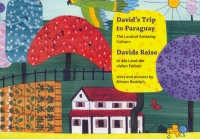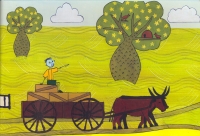| ________________
CM . . . . Volume XVIII Number 39 . . . . June 8, 2012

 |
David’s Trip to Paraguay, the Land of Amazing Colours = Davids Reise in das Land der vielen Farben.
Miriam Rudolph.
Winnipeg, MB: CMU Press, 2011.
32 pp., hardcover, $22.00
ISBN 978-0-920718-91-9.
Grades 1-3 / Ages 6-8.
Review by Sabrina Wong.
*1/2 /4
|
| |
|

excerpt:
“Tell me a story grandpa,” I said and grandpa told me about snow fields and trains, the ocean and ships, flying fish and crocodiles and about the country of amazing colours: PARAGUAY.”
In David’s Trip to Paraguay, the Land of Amazing Colours, Miriam Rudolph tells the story of her grandfather David’s migration from Manitoba to Paraguay when he was nine years old. Rudolph, who works as an artist, also created the illustrations that accompany the story. The story is told in both English and German, shown side by side, an homage to her family’s Canadian and Mennonite roots. 
The transition from snowy Canada to sunny Paraguay is highlighted by Rudolph’s colour palette in her illustrations. In Canada, “the colours were hidden under ice and snow” (p. 6), so accordingly the landscape is depicted in muted grays, purples and dark reds, while tropical Paraguay is bright and saturated in colour. Rudolph uses mixed media, acrylic and ink on paper to achieve a child-like aesthetic. While this illustration style can work for some stories, Rudolph has perhaps carried it too far. In the illustration of the Vandijk’s arrival in Buenos Aires (p. 19), a select few buildings and monuments are depicted simply and solidly with pen and blocks of solid colour; these contrast with the boats, which are oversimplified to the point where they look like bowls floating in an ochre-toned watercolour field. Some of the lines look as if they were done with a blue ballpoint pen, which gives the overall impression of sloppiness, rather than conveying the care that Rudolph must have put into each illustration. Paraguay may be “the land of amazing colours,” but the use of stick figures and simple shapes detracts from the richness and vivacity of David’s journey.
It is clever that all of the illustrations can be connected linearly as seen in the endpapers; however, in the story itself, the illustrations appear disjunctive since they are confined to the right page in each spread. In addition, this page layout isolates the text from the illustrations; only one element from the illustration on the right-hand page is carried over to the left side. The effect is that the interaction between text and picture is static and somewhat forced. The scene in Barbados with the diving islanders (p. 14-15) has motion and action, but that feeling is not carried over to the text. It seems wholly unconnected, as if the text and illustrations were created as separate entities rather than designed together as a whole.
It is difficult to determine for what age group or reading level Rudolph has written this book since it is inconsistent with its expectations from the reader. While the repetition of the line, “he knew he was going the right way” (p. 10) indicates a younger reader, the use of words like “ochre,” “loamy” and “steamer” (p. 18) require an older reader with a more sophisticated vocabulary. However, the simplicity of the story would not draw in an older reader: there is no compelling context or situation - David simply sees a lot of differently coloured objects and animals as he travels south. Rudolph utilizes colours and pictorial similes to describe the visual aspects of her grandfather’s journey. However, by focussing so tightly on the things that David saw, Rudolph misses the opportunity to paint David as a multidimensional character. Like the illustrations, David is flat: he sees amazing things, but his only reaction is to feel confident that he is heading the right way. It does not help that his story is told in the third person and uses the past tense. The reader, rather than engaging with David’s journey as it happens, is resigned to watching the replay.
The historical context of David’s journey to Paraguay is not included in the story but is explained in the acknowledgements afterwards. After World War I, the Canadian government restricted the freedom of the Mennonite community to have German schools, and so many southern Manitoba Mennonites moved to Paraguay, founding the community of Loma Plata where Rudolph grew up. Rudolph wrote this story after returning to Manitoba where her grandparents originally lived. Rather than a big block of small-sized text, it would be helpful if Rudolph adopted the example of other historical children’s fiction and modified this acknowledgement passage into a short historical note that informs the reader about the context of the story. While Rudolph explains that she wanted to focus on the positive aspects of the journey, as her grandfather did, an understanding why David and his family suddenly left Manitoba would have immensely enriched the story that she told.
After using every colour of the rainbow to describe Paraguay, the book closes with, “When David saw all these wonderful colours and the sun in the sky he knew he was at home” (p. 28). The slight change in the repeating line is a common way to wrap up a story. However, when it is paired with the other common opening device of “tell me a story,” the whole story seems contrived and unoriginal. Her grandfather’s story has the potential to be useful for sparking discussions about Mennonite history, migrations and cultural heritage, but Rudolph has taken the fascinating context out of his journey and rendered it into a book about many colours.
Not recommended.
Sabrina Wong is a MLIS candidate at UBC’s School of Library, Archival and Information Studies.

To comment
on this title or this review, send mail to cm@umanitoba.ca.
Copyright © the Manitoba Library Association. Reproduction for personal
use is permitted only if this copyright notice is maintained. Any
other reproduction is prohibited without permission.
NEXT REVIEW |
TABLE OF CONTENTS FOR THIS ISSUE
- June 8, 2012.
AUTHORS |
TITLES |
MEDIA REVIEWS |
PROFILES |
BACK ISSUES |
SEARCH |
CMARCHIVE |
HOME |

